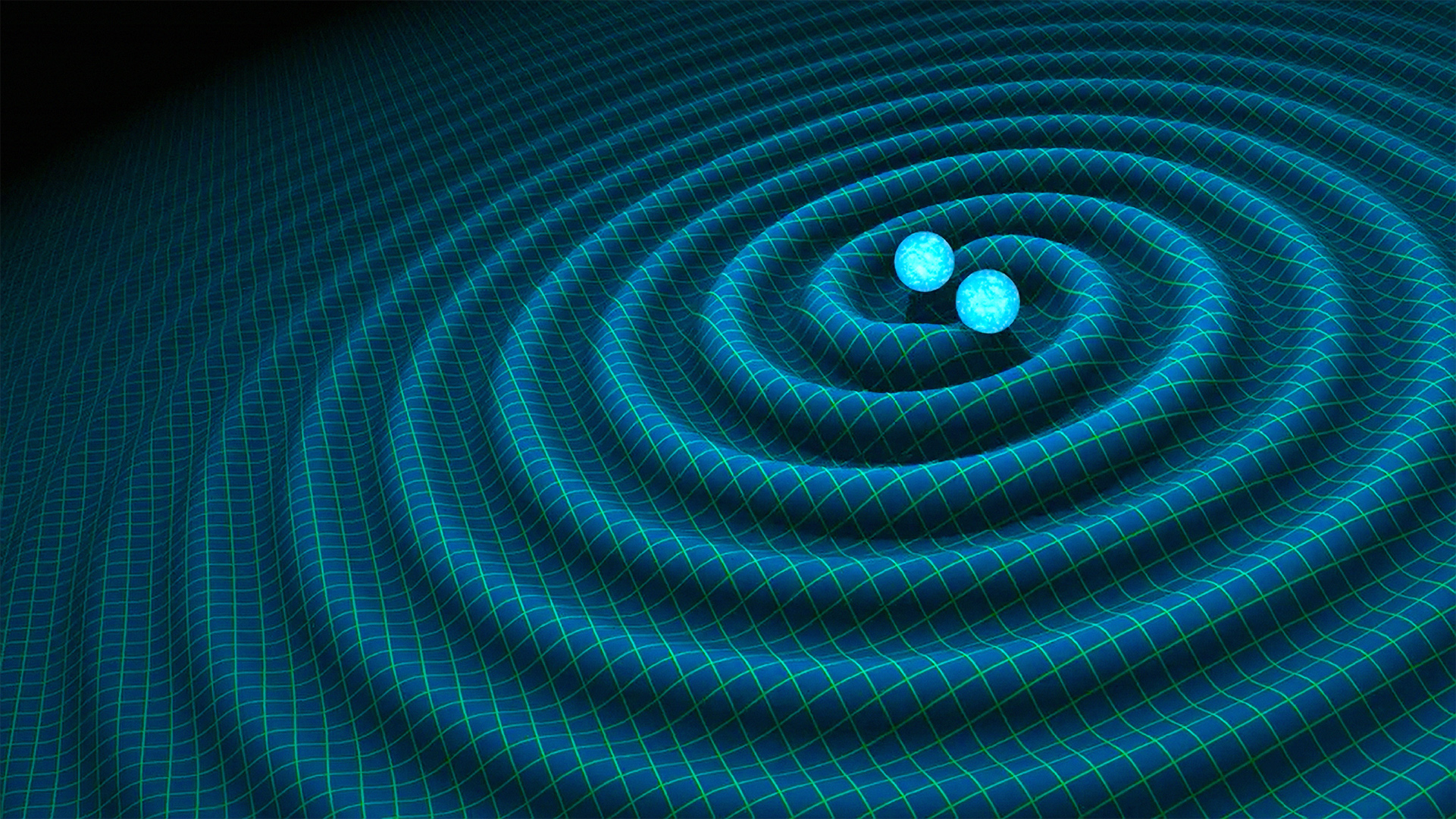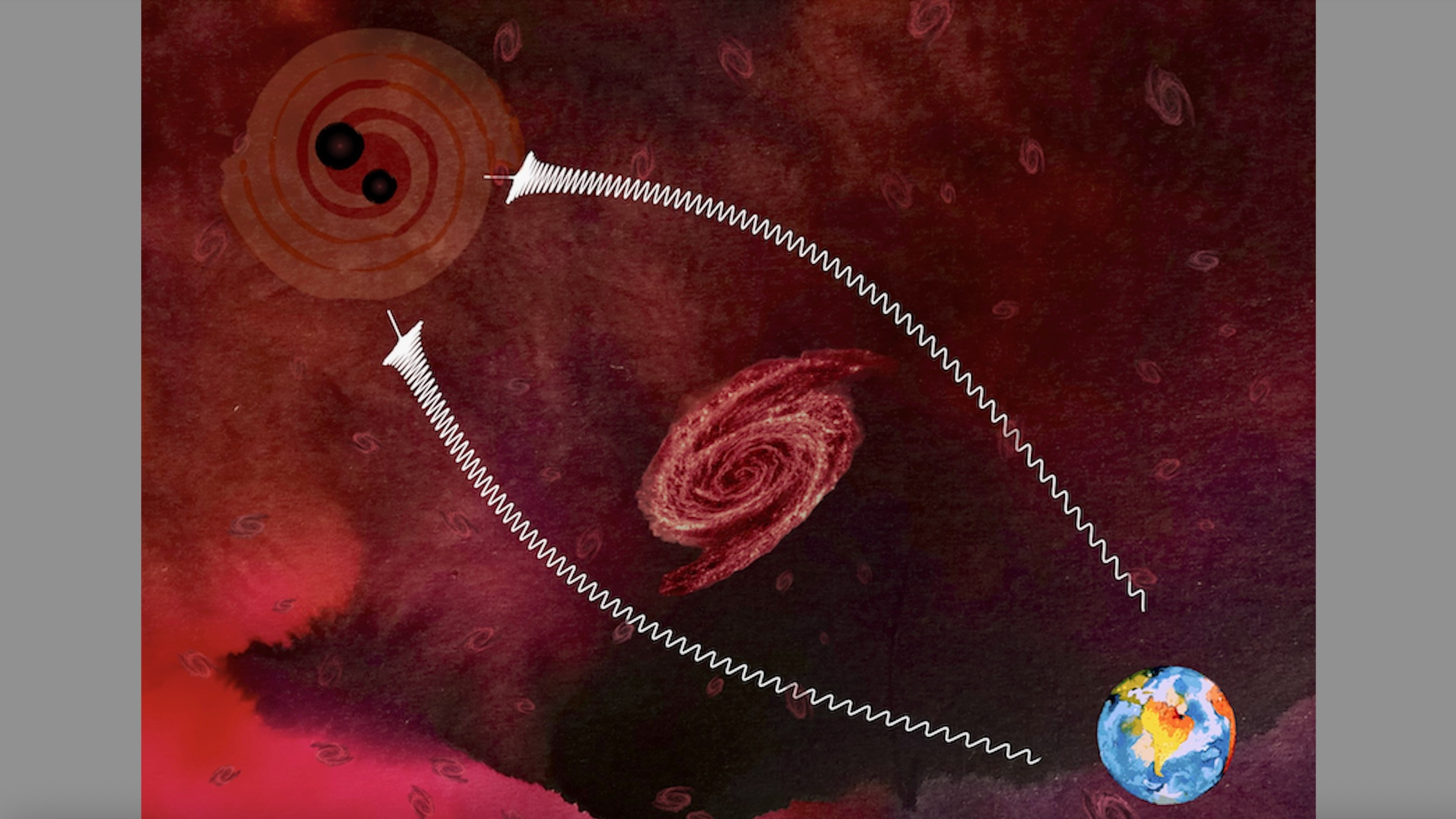Gravitational waves could help us find out how fast the universe's expansion is accelerating
A new way to measure the cosmic expansion rate could help resolve a long-standing cosmological crisis.

Gravitational waves emitted when distant black holes collide and merge, causing the very fabric of space-time to ring like a bell, could be used to help measure the rate at which the universe is expanding, a new study reports.
Since the late 1990s, astronomers have known that not only is the universe expanding, but it is doing so at an accelerating rate. The cause of this so-called late-time acceleration has remained mysterious, earning itself the placeholder name "dark energy."
And researchers have been puzzled by the fact that the two main ways to measure cosmic expansion give different values for the rate, which is called the Hubble constant. This discrepancy has remained, even as both methods have become more precise over the years.
Related: 'Hubble trouble' could deepen with new measurement of the universe's expansion
These two techniques are the "late-time" method, which considers the velocity of galaxies and their distance from us, and the "early time" method, which studies the "fossil light" from just after the Big Bang called the cosmic microwave background.
Late-time measurements currently give an expansion rate of roughly 73 ± 1 kilometers per second per megaparsec, while early-time measurements give a value of 67.5 ± 0.5 km/s per megaparsec.
This has led scientists to search for a corroborating method for measuring the Hubble constant. And that's where the new study comes in.
Breaking space news, the latest updates on rocket launches, skywatching events and more!

Gravitational lensing and gravitational waves
The new study suggests the use of a phenomenon predicted by Albert Einstein and usually associated with the distortion of light called gravitational lensing to measure the Hubble constant.
Gravitational lensing is an effect that arises from Einstein's theory of general relativity. The great physicist's 1915 theory of gravity predicts that mass has a warping effect on space and time, united as a four-dimensional entity called space-time.
This warping means that, when light from a background source passes an object of great mass like a galaxy, its path is bent by this "gravitational lens." This effect can result in the magnification of the background source, and it is used to great effect to see early galaxies by observatories like NASA's James Webb Space Telescope (JWST).
Gravitational lensing is usually associated with light. But gravitational waves — ripples in space-time created by accelerating objects of enormous mass, such as two black holes spiraling toward each other — should be similarly affected. That means gravitational waves from these violent merger events should also display gravitational lensing, as light does.
Light can take different paths past a lensing object because the amount it is deflected depends on how close it comes to the gravitational lens. This means the light arrives at Earth at different times, and this time delay can result in the same object appearing in multiple places in a single image. As gravitational waves can also take varying paths past a gravitational lens, they should also display a similar arrival time delay, meaning that gravitational wave detectors could, in theory, detect gravitational waves from the same event at different times.
This can be used as a measure of the Hubble constant, study team members said. That's because the rate of the universe's expansion influences the distance between sources of gravitational waves — black hole mergers, for example — and the galaxy that is warping space-time and acting as the gravitational lensing and the distance to Earth.
The team said that the amount of gravitational-wave lensing should depend on the expansion rate of the universe and, thus, the Hubble constant. They suggest that a larger Hubble constant would result in a higher fraction of lensed black hole mergers and also smaller values of time delay compared to what would be seen in the case of a smaller Hubble constant.
Related: The gravitational wave background of the universe has been heard for the 1st time
You wait ages for a gravitational wave, and then two come along at once…
The advantage of measuring the expansion rate of the universe with gravitational waves rather than light is that these ripples are unaffected when they pass through massive gas and dust clouds, whereas light can be absorbed or have its frequency changed. This means the technique could allow astronomers to "see" further back into the history of the universe than is allowed by even strongly lensed light.
Scientists haven't yet detected a strong gravitational lensing effect on gravitational waves from merging black holes, and the technique suggested by the team will depend on a catalog of thousands of gravitational wave events, which isn't available yet. The first gravitational waves were first detected just in 2015, so this is still a new area of science. Yet major developments are afoot.
The sensitivity of ground-based gravitational wave detectors has been improving with recent significant upgrades to the Laser Interferometer Gravitational-Wave Observatory (LIGO), Virgo, and the Kamioka Gravitational Wave Detector (KAGRA). Additionally, the first space-based gravitational wave detector, Europe's Laser Interferometer Space Antenna (LISA), is set to launch in 2037.
With these improved instruments, scientists could start to build a database that allows for the observation of gravitational lensing in gravitational waves. In this data, the team expects to find a small fraction of repeated signals from the same black hole merger events, just like the same distant light sources appear multiple times in JWST images due to gravitational lensing.
"A major scientific goal of future detectors is to deliver a comprehensive catalog of gravitational wave events, and this will be a completely novel use of the remarkable dataset," study co-author Tejaswi Venumadhav Nerella, a theoretical astrophysicist at the University of California, Santa Barbara, said in a statement.
The research was published on June 30 in the journal Physical Review Letters.

Robert Lea is a science journalist in the U.K. whose articles have been published in Physics World, New Scientist, Astronomy Magazine, All About Space, Newsweek and ZME Science. He also writes about science communication for Elsevier and the European Journal of Physics. Rob holds a bachelor of science degree in physics and astronomy from the U.K.’s Open University. Follow him on Twitter @sciencef1rst.
